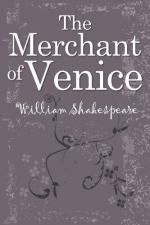|
This section contains 1,699 words (approx. 6 pages at 300 words per page) |

|
SOURCE: Fischer, Susan L. Review of The Merchant of Venice. Shakespeare Bulletin 20, no. 1 (winter 2002): 30-1.
In the following review, Fischer calls Hansgünther Heyme's 2002 staging of The Merchant of Venice a “postmodern, transcultural production,” incorporating elements of Erwin Piscator's “Epic Theatre” as well as Noh theatre.
Hansgünther Heyme's The Merchant of Venice, with its ideological stress on theatre as a form of “provocation” and its deployment of anti-illusionary techniques of “objective acting” and non-verbal gestures of “showing,” evinced an affinity with the “Epic Theatre” of his mentor, Erwin Piscator. It also alluded to Noh theatre. “Where does good end, and where does evil begin?” That was the question implicating all of the characters in this postmodern, transcultural production. According to the director, the only surety in the marshy terrain of Venice, as well as in the ideal world of Belmont, was money. Everything could be bought, and...
|
This section contains 1,699 words (approx. 6 pages at 300 words per page) |

|


